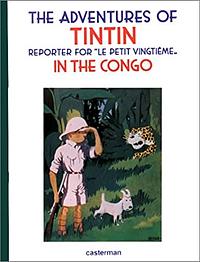You need to sign in or sign up before continuing.
Take a photo of a barcode or cover
I grew up with the French version, and as my French is woefully weak, I could only 'read' the story by looking at the pictures. At that time, my issue was with Tintin's determination to exterminate all animal life in Africa.
Reading it in English and knowing the issues that people have had with the book, I can see why they have their issues with it, but my feelings haven't changed. The story is a bit meh, though.
Reading it in English and knowing the issues that people have had with the book, I can see why they have their issues with it, but my feelings haven't changed. The story is a bit meh, though.
1,5⭐️ – Bon, je sais que c’est une vieille histoire mais c’est quand même choquant de lire une histoire aussi raciste… sans parler de la cruauté animal
Um. So this book was a combination of racism and just ridiculous animal violence. Native Africans who are drawn strangely similar to the monkeys. A monkey being shot and then Tintin wearing his skin as a suit to get the stupid dog back from another monkey. Tintin putting a stick of dynamite into a rhino to blow it up. Just.... why? Also the lack of plot was really frustrating. Like oh, the dog is fighting a parrot. Now he's gone overboard. And now he's back and we're hunting. And we couldn't get that so we're doing something else. It just felt like a random series of unrelated scenes all taking place in a weird racist way.
aduh.. harus kasih bintang 2 aja, kasian sama binatang-binatang yang ditembaki Tintin :(
Snowy kasian juga sih, ikut yang punya ya kayaknya punya banyak nyawa gitu :D
buku kedua dan masih belum berwarna..
Snowy kasian juga sih, ikut yang punya ya kayaknya punya banyak nyawa gitu :D
buku kedua dan masih belum berwarna..
La primera aventura de Tintin es bastante chorra, la verdad, siendo más bien un conjunto de situaciones hiladas de manera muy vaga. Cosas curiosas que no recordaba: Tintín y su perro hablan. De hecho, Tintín también habla con un mono.
Por supuesto, hay un racismo atroz, cosa que no me extraña de un autor belga en 1946, y además Tintín tiene un desprecio absoluto por la vida animal: Tintín masacra un elefante por sus colmillos, usa un cartucho de dinamita para cazar a un rinoceronte que no le había hecho absolutamente nada, y se pela a tiros una población entera de antílopes entre otros. A muchos les daría un ataque. Pero de nuevo, eran otros tiempos.
¿Es imprescindible? En absoluto. Uno se puede perder el comic sin problema. Vale, es el primero y Hergé estaba probablemente buscando el tipo de historia que quería contar. No es terrible, pero sí olvidable.
Por supuesto, hay un racismo atroz, cosa que no me extraña de un autor belga en 1946, y además Tintín tiene un desprecio absoluto por la vida animal: Tintín masacra un elefante por sus colmillos, usa un cartucho de dinamita para cazar a un rinoceronte que no le había hecho absolutamente nada, y se pela a tiros una población entera de antílopes entre otros. A muchos les daría un ataque. Pero de nuevo, eran otros tiempos.
¿Es imprescindible? En absoluto. Uno se puede perder el comic sin problema. Vale, es el primero y Hergé estaba probablemente buscando el tipo de historia que quería contar. No es terrible, pero sí olvidable.
Unas cuantas historias sin hilo conductor, y racismo a puñados. Es evidente que es el primer volumen y el autor busca qué hacer con el personaje.
dark
reflective
tense
slow-paced
Plot or Character Driven:
Character
Strong character development:
No
Loveable characters:
No
Diverse cast of characters:
Complicated
Flaws of characters a main focus:
No
This book is racist. There’s no other way to say it. Tintin has been an enduring loved comic book character for decades. These adventures brought the bumbling detective to life and made them a part of our lexicon. But sometimes classic characters in fall to the changing of time. The illustrations are in typical black face. Not drawing a black person is a black person but drawing them as a monkey painted black as you would see in old vaudeville acts. Completely inappropriate. Then add the language barriers, and how none of these black characters speak proper English. It’s all broken or comical, or made to show more differences then should be relevant. Then add the white saviorism. Tintin has gone to the Congo to write about his adventures with the great apes and acts like an unneeded hero. Whether it’s fighting lions, riding crocodiles, or saving a group from a different man, Tintin wants to be the hero. I know this book is a product of its time, but this is not one a library should have on their shelves, unless the library specifically keeps collections of old children’s books for purposes of study. Tintin can do better. This book has been banned. I agree with the ban in this case. There are better books and better characters.
Writing in English too because whatever.
Dealing with Hergé's racism is hard. In some ways he was incredibly progressive (such as his relatively sympathetic portrayal of Asian characters as being just as varied and nuanced as European characters), and in others, not so much (Tintin en Amérique, au Congo, etc.).
I'm a diehard Hergé fan. I love Tintin; I own all the books; I first read the Tintin comics obsessively when I was a kid, and have loved them ever since. But then there's this shit:

or this:

which is just, yeah. Inexcusable.
For what it's worth, Hergé didn't like it either, and later said that he would do it entirely differently if he had an opportunity to do it again (he was only 22 when this particular BD was published). He also changed certain sections in the re-issue to be less grossly racist.
I don't think this book should necessarily be censored. I think it should be taught to children (or adults!) reading it for the first time that this was not only a different time and thus expectations differed, but also that this sort of thing was offensive even at the time. Yes, this BD is racist. Yes, it is unpleasant to read. Yes, it's still a cultural artefact, and an important one—Hergé did improve and change with time, which is the best possible development. So no, I don't "like" this comic, but I understand it.
L’album Tintin au Congo demeure l’un des plus gros succès d’Hergé, après Tintin en Amérique, avec plus de 10 millions d’exemplaires vendus dans le monde. Après le triomphe de Tintin au pays des Soviets, paru en 1929, le directeur du journal demande alors à Georges Remi d’enchaîner les aventures de Tintin en Afrique, et plus précisément au Congo, sous domination belge depuis 1908. À l’époque, les aventures de Tintin au pays des Soviets ont rencontré un très large succès auprès des enfants. Un deuxième épisode au Congo belge est l’occasion d’insuffler les valeurs colonialistes à un jeune lectorat.
Dans un entretien enregistré en 1979 sur la RTBF, diffusé pour la première fois sur France Culture le 21 juillet 1993, Hergé revenait sur Tintin au Congo :
Actuellement, si certaines maisons d'éditions étrangères ont fait le choix d'écrire un avertissement de remise en contexte dans les premières pages de Tintin au Congo, certaines librairies ont fait le choix de déplacer l'album du rayon pour enfants à celui des adultes. (Par exemple c'est le cas en Angleterre, en Australie ou encore en Nouvelle-Zélande.)
Dealing with Hergé's racism is hard. In some ways he was incredibly progressive (such as his relatively sympathetic portrayal of Asian characters as being just as varied and nuanced as European characters), and in others, not so much (Tintin en Amérique, au Congo, etc.).
I'm a diehard Hergé fan. I love Tintin; I own all the books; I first read the Tintin comics obsessively when I was a kid, and have loved them ever since. But then there's this shit:

or this:

which is just, yeah. Inexcusable.
For what it's worth, Hergé didn't like it either, and later said that he would do it entirely differently if he had an opportunity to do it again (he was only 22 when this particular BD was published). He also changed certain sections in the re-issue to be less grossly racist.
I don't think this book should necessarily be censored. I think it should be taught to children (or adults!) reading it for the first time that this was not only a different time and thus expectations differed, but also that this sort of thing was offensive even at the time. Yes, this BD is racist. Yes, it is unpleasant to read. Yes, it's still a cultural artefact, and an important one—Hergé did improve and change with time, which is the best possible development. So no, I don't "like" this comic, but I understand it.
L’album Tintin au Congo demeure l’un des plus gros succès d’Hergé, après Tintin en Amérique, avec plus de 10 millions d’exemplaires vendus dans le monde. Après le triomphe de Tintin au pays des Soviets, paru en 1929, le directeur du journal demande alors à Georges Remi d’enchaîner les aventures de Tintin en Afrique, et plus précisément au Congo, sous domination belge depuis 1908. À l’époque, les aventures de Tintin au pays des Soviets ont rencontré un très large succès auprès des enfants. Un deuxième épisode au Congo belge est l’occasion d’insuffler les valeurs colonialistes à un jeune lectorat.
Dans un entretien enregistré en 1979 sur la RTBF, diffusé pour la première fois sur France Culture le 21 juillet 1993, Hergé revenait sur Tintin au Congo :
Après l’album Tintin chez les Soviets, je voulais faire Tintin en Amérique, pour renvoyer les deux puissances dos à dos. Mais entre-temps, le directeur du journal m’a presque supplié et m’a dit : Vous ne pouvez pas faire ça, notre belle colonie, le Congo, Léopold II, les missionnaires, nous qui leur apportons la civilisation, etc. Alors, j’ai fait Tintin au Congo sans grand enthousiasme. Si je devais réécrire Tintin au Congo aujourd’hui, cela serait très différent. Mais tout a évolué et changé, moi aussi j’ai changé. Tintin reporter est un miroir, d’ailleurs tout journaliste est une espèce de miroir qui reflète les événements qu’il va regarder. Tintin a été le miroir de ce que la plupart des gens pensaient du temps de la Russie bolchevique. Quant à l’idée colonialiste, pratiquement tout le monde a été colonialiste. Cela ne posait pas de problème, le Blanc avait été créé pour apporter la civilisation aux autres. Tintin n’était pas raciste mais il était colonialiste comme tout le monde l’était à l’époque.À l'époque, le dessinateur a 22 ans, et n’a jamais mis les pieds en Afrique. Contrairement au travail de documentation qu’il entreprendra pour Tintin et le lotus bleu quatre années plus tard avec l’aide de son ami chinois, pour Tintin au Congo, Hergé se contente des quelques articles de presse sur le Congo qu’il découpe ici et là.
Actuellement, si certaines maisons d'éditions étrangères ont fait le choix d'écrire un avertissement de remise en contexte dans les premières pages de Tintin au Congo, certaines librairies ont fait le choix de déplacer l'album du rayon pour enfants à celui des adultes. (Par exemple c'est le cas en Angleterre, en Australie ou encore en Nouvelle-Zélande.)
adventurous
funny
lighthearted
relaxing
fast-paced
Plot or Character Driven:
Plot
Strong character development:
N/A
Loveable characters:
Yes
Diverse cast of characters:
Yes
Flaws of characters a main focus:
N/A
adventurous
funny
lighthearted
fast-paced
Plot or Character Driven:
Character
Strong character development:
No
Loveable characters:
Yes
Diverse cast of characters:
N/A
Flaws of characters a main focus:
No






